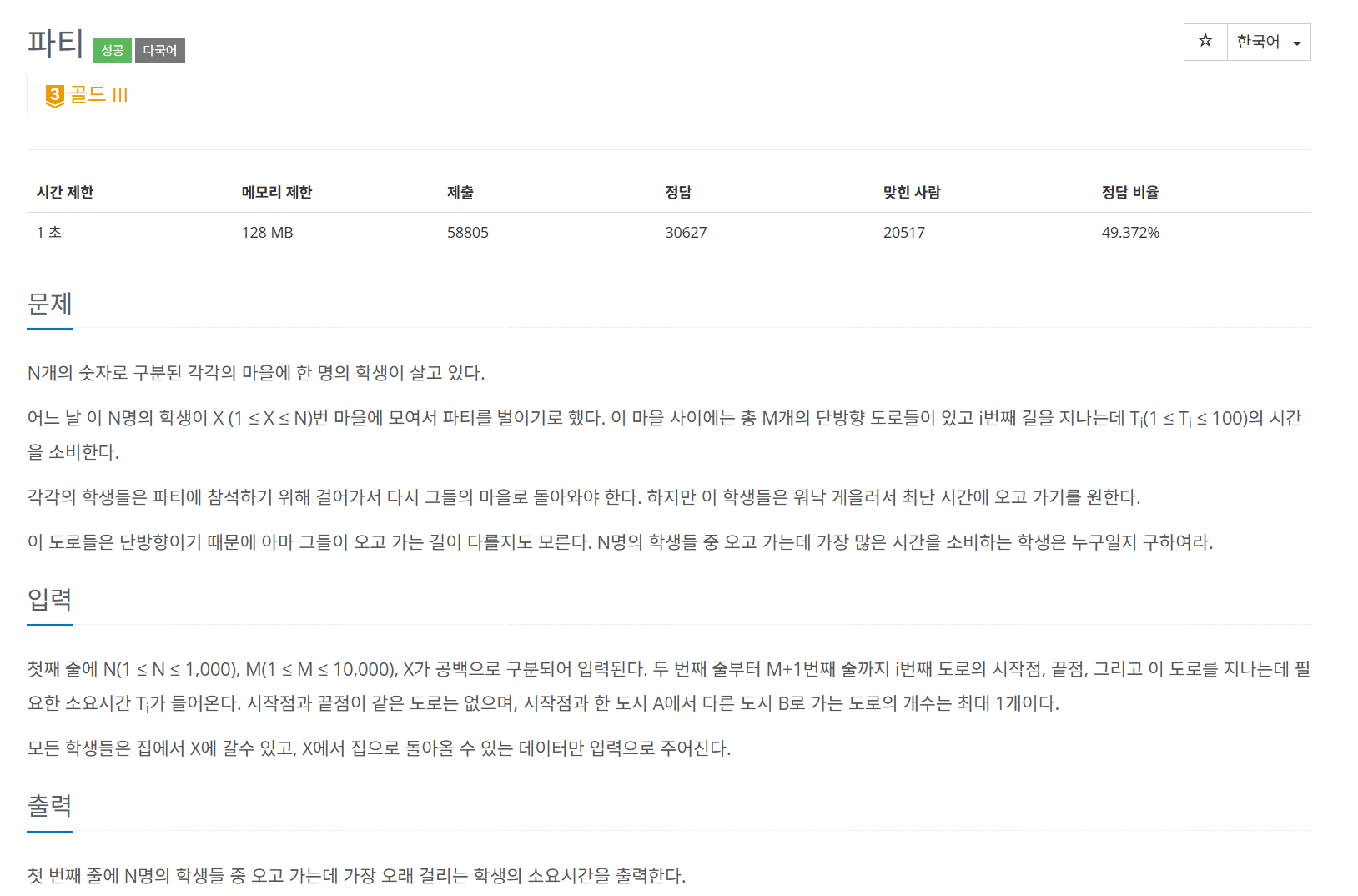🧫 문제 분석
✔️ 출처
📖 문제

O(N^3) 인 플로이드 워샬은 사용불가능하고,
다익스트라로 풀어야하는 문제다.
그런데 X→모든 정점은 구하겠는데
모든 정점→X를 편하게 구하는 법을 몰라서
각 정점에서 다익스트라 알고리즘을 돌려서 X까지의 값을 구하는 식으로 했다.
이 후 다른 사람의 풀이를 봤는데
정말 놀랍다.
단방향이지만 역방향으로 그래프를 만들어서
// 기존
X -> All
All -> X
// 다른사람들의 풀이
X -> All
X <- All로 X에서 모든정점으로 가는 그래프를 만들고
X로 오는 모든 정점으로 가는 역방향 그래프를 만드는 것이다.
좋은 것을 배웠다..
🔅 문제 풀이 [x→ all → x]
import java.io.*;
import java.util.*;
public class Main {
static class Node {
int idx;
int cost;
public Node(int idx, int cost) {
this.idx = idx;
this.cost = cost;
}
}
static List<Node>[] graph;
public static void main(String[] args) throws IOException {
BufferedReader br = new BufferedReader(new InputStreamReader(System.in));
BufferedWriter bw = new BufferedWriter(new OutputStreamWriter(System.out));
StringTokenizer st = new StringTokenizer(br.readLine());
int n = Integer.parseInt(st.nextToken());
int m = Integer.parseInt(st.nextToken());
int x = Integer.parseInt(st.nextToken());
int[] xToAllDiff = new int[n + 1];
int[] AllToXDiff = new int[n + 1];
graph = new List[n + 1];
for (int i = 1; i <= n; i++) {
graph[i] = new ArrayList<>();
}
for (int i = 1; i <= m; i++) {
st = new StringTokenizer(br.readLine());
int A = Integer.parseInt(st.nextToken());
int B = Integer.parseInt(st.nextToken());
int T = Integer.parseInt(st.nextToken());
graph[A].add(new Node(B, T));
}
//x -> 모든 정점으로의 최단거리
Arrays.fill(xToAllDiff, Integer.MAX_VALUE);
xToAllDiff[x] = 0;
bfs(x, xToAllDiff);
// 오고 가는데 가장 오래걸리는 소요시간 구하기
// 모든 정점 -> x 까지 최단거리
int max = 0;
for (int i = 1; i <= n; i++) {
Arrays.fill(AllToXDiff, Integer.MAX_VALUE);
AllToXDiff[i] = 0;
bfs(i, AllToXDiff);
// i -> x + x -> i 까지 가는데 최단거리의 합중 최댓값을 갱신
if (AllToXDiff[x] + xToAllDiff[i] > max) {
max = AllToXDiff[x] + xToAllDiff[i];
}
}
System.out.println(max);
}
private static void bfs(int start, int[] diff) {
PriorityQueue<Node> pq = new PriorityQueue<>((o1, o2) -> o1.cost - o2.cost);
pq.add(new Node(start, 0));
while (!pq.isEmpty()) {
Node current = pq.poll();
List<Node> list = graph[current.idx];
for (Node node : list) {
if (diff[node.idx] > node.cost + diff[current.idx]) {
diff[node.idx] = node.cost + diff[current.idx];
pq.add(new Node(node.idx, diff[node.idx]));
}
}
}
}
}
🔅 문제 풀이 [x→ all, ← all]
import java.io.*;
import java.util.*;
public class Main {
static class Node {
int idx;
int cost;
public Node(int idx, int cost) {
this.idx = idx;
this.cost = cost;
}
}
static int n;
public static void main(String[] args) throws IOException {
BufferedReader br = new BufferedReader(new InputStreamReader(System.in));
BufferedWriter bw = new BufferedWriter(new OutputStreamWriter(System.out));
StringTokenizer st = new StringTokenizer(br.readLine());
n = Integer.parseInt(st.nextToken());
int m = Integer.parseInt(st.nextToken());
int x = Integer.parseInt(st.nextToken());
int[] xToAllDiff = new int[n + 1];
int[] AllToXDiff = new int[n + 1];
List<Node>[] graph = new List[n + 1];
List<Node>[] reverseGraph = new List[n + 1];
for (int i = 1; i <= n; i++) {
graph[i] = new ArrayList<>();
reverseGraph[i] = new ArrayList<>();
}
for (int i = 1; i <= m; i++) {
st = new StringTokenizer(br.readLine());
int A = Integer.parseInt(st.nextToken());
int B = Integer.parseInt(st.nextToken());
int T = Integer.parseInt(st.nextToken());
graph[A].add(new Node(B, T));
reverseGraph[B].add(new Node(A, T));
}
//x -> 모든 정점으로 가는 최단거리
Arrays.fill(xToAllDiff, Integer.MAX_VALUE);
bfs(x, xToAllDiff, graph);
// x <- 모든정점으로 오는 최단거리
Arrays.fill(AllToXDiff, Integer.MAX_VALUE);
bfs(x, AllToXDiff, reverseGraph);
// 오고 가는데 가장 오래걸리는 소요시간 구하기
// 모든 정점 -> x 까지 최단거리
int max = 0;
for (int i = 1; i <= n; i++) {
// i -> x + x -> i 까지 가는데 최단거리의 합중 최댓값을 갱신
if (AllToXDiff[i] + xToAllDiff[i] > max) {
max = AllToXDiff[i] + xToAllDiff[i];
}
}
System.out.println(max);
}
private static void bfs(int start, int[] diff, List<Node>[] graph) {
PriorityQueue<Node> pq = new PriorityQueue<>((o1, o2) -> o1.cost - o2.cost);
boolean[] visited = new boolean[n + 1];
pq.add(new Node(start, 0));
diff[start] = 0;
while (!pq.isEmpty()) {
Node current = pq.poll();
if (visited[current.idx]) continue;
visited[current.idx] = true; // 우선순위 큐를 사용했으므로 이미 최솟값임 따라서 방문처리
List<Node> list = graph[current.idx];
for (Node node : list) {
if (diff[node.idx] > node.cost + diff[current.idx]) {
diff[node.idx] = node.cost + diff[current.idx];
pq.add(new Node(node.idx, diff[node.idx]));
}
}
}
}
}❗ 오답노트 / 필요한 지식
'baekjoon > Graph_Search' 카테고리의 다른 글
| 백준 2632번 : 음악프로그램 [자바] (1) | 2025.05.30 |
|---|---|
| 백준 2638번 : 치즈 [자바] (0) | 2025.04.12 |
| 백준 1504번 : 특정한 최단 경로 [자바] (0) | 2025.03.31 |
| 백준 1389번 : 케빈 베이컨 6단계 법칙 [자바] (0) | 2025.03.26 |
| 백준 4179번 : 불! [자바] (0) | 2025.03.19 |
